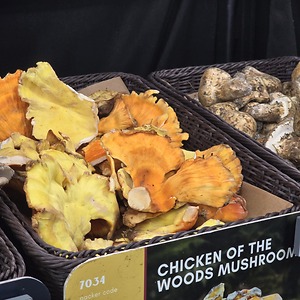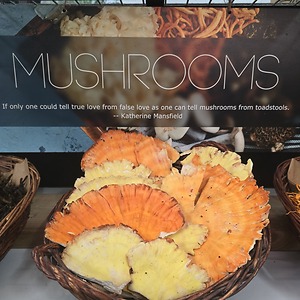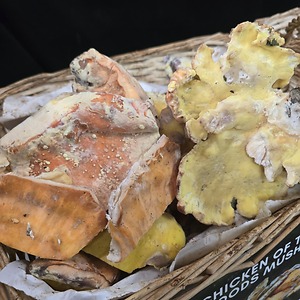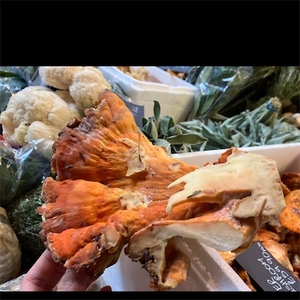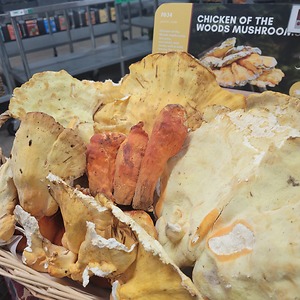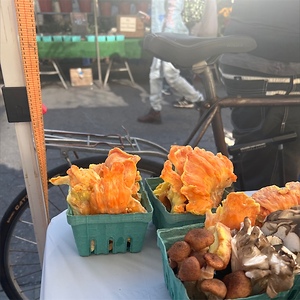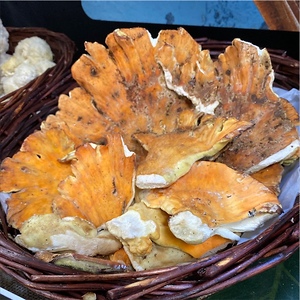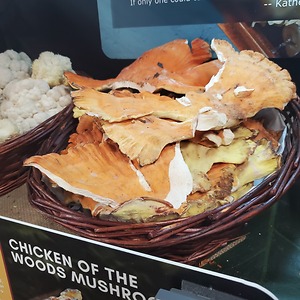


Chicken of the Woods Mushrooms
Estimated Inventory, lb : 0
This item was last sold on : 11/20/24
Description/Taste
Chicken of the Woods mushrooms vary in size and shape, depending on their maturity, specific species, and growing conditions. The mushrooms generally average 10 to 40 centimeters in width and 3 to 12 centimeters in thickness and are comprised of shelf-like brackets that grow in clusters on the sides of trees. These individual brackets are grouped together to form the whole fruiting body, and some Chicken of the Woods fruiting bodies can grow very large and extend over 90 centimeters in width. Each bracket, also known as a cap, has a semicircular, flat, broad, fan-like shape and the edges can be wavy or straight. Young Chicken of the Woods mushroom caps are smooth or slightly wrinkled and showcase bright orange and yellow-striped, banded hues. The caps are fleshy, moist, spongy, and thick with a suede-like feel. When sliced open, young caps will release a clear liquid. As the caps mature, they begin to fade to a dull white and become thin, dry, brittle, crumbly, and chalky. Underneath the caps are tightly packed pores appearing in shades of white, yellow and pink. These pores release white or yellow spores, depending on the species. Chicken of the Woods mushrooms emit a strong earthy and woodsy aroma and are only edible once cooked. The mushrooms are known for developing a succulent, chewy, and meat-like consistency when cooked and have a mild, slightly sour taste with subtle citrus nuances. Some consumers note that their flavor is reminiscent of chicken, lobster, or crab.
Seasons/Availability
Chicken of the Woods mushrooms are available from early spring through winter, depending on the growing region, and typically have a peak season in the summer and fall.
Current Facts
Chicken of the Woods mushrooms are botanically a part of the Laetiporus genus and belong to the Laetiporaceae family. There are several species within the Laetiporus genus with similar characteristics that are collectively grouped under the Chicken of the Woods name and the most prominent and well-known species is Laetiporus sulphureus. Chicken of the Woods mushrooms are ancient mushrooms that have been foraged from the wild for generations as a culinary delicacy. The mushrooms are regarded as one of the easiest wild fungi to identify as they are brightly colored and generally have no poisonous look-a-likes. They also typically appear in the same location each year, depending on the weather and growing conditions. Chicken of the Woods mushrooms are a type of polypore bracket fungus, meaning their disperse spores through small pores instead of gills. The mushrooms grow in shelf-like tiers on the sides of trees and are hand harvested for use in a wide array of cooked dishes. In the modern day, Chicken of the Woods mushrooms have gained notoriety for their similarity in texture and flavor to meat. This is where the mushrooms acquired their “chicken” moniker, and they are popularly used as a meat substitute in vegetarian dishes.
Nutritional Value
Chicken of the Woods mushrooms are a source of vitamins A and C, encouraging healthy eyesight, immune function, and collagen production. These mushrooms also provide vitamins E, B, and D, protecting the cells against free radical damage, building healthy bones, and assisting the body in producing energy. Chicken of the Woods mushrooms are known for being a complete protein, an important source for vegetarians. The mushrooms also contain potassium to balance fluid levels in the body, fiber to regulate the digestive tract, magnesium to control nerve functions, and other nutrients, including niacin, phosphorus, and riboflavin. It is important to note that small quantities of mushrooms should be first consumed to determine if they are safe to eat. Everyone is different, and some consumers can have low allergic reactions to specific types of mushrooms. This is applicable for any mushroom, and it is up to the discretion of the consumer to determine individual needs.
Applications
Chicken of the Woods mushrooms have a mild, neutral flavor suited for cooked preparations. The mushrooms must always be cooked before consumption and are highly favored for their chicken or seafood-like texture. Chicken of the Woods mushrooms are a common meat substitute in culinary dishes. The mushrooms can be breaded and fried into cutlets, sauteed with wine or butter, or simmered into soup stocks for added flavoring. Try adding Chicken of the Woods mushrooms into classic chicken or tofu dishes as a twist on the classic recipe. Chicken of the Woods mushrooms are versatile and can add texture to stir-fries, pasta dishes, and casseroles. The mushrooms can also be fried into tempura, roasted as a side dish, or incorporated into sauces for meat main dishes. The mushroom’s hardier nature allows it to be cooked in gravies, sauces, soups, and stews. They can also be diced into smaller pieces and pickled for extended use. Chicken of the Woods mushrooms pair well with asparagus, peas, herbs such as chives, cilantro, and parsley, aromatics including garlic, onions, and ginger, and potatoes. Whole, unwashed mushrooms should be cleaned and immediately used for the best quality and flavor. They will also keep up to a week when stored in a paper bag in the refrigerator and can be cooked and frozen for longer storage.
Ethnic/Cultural Info
Chicken of the Woods mushrooms are also commonly known as Sulphur Shelf mushrooms in English speaking regions worldwide. This name is derived from the species name, Laetiporus sulphureus. Laetiporus is derived from Latin with “laet” meaning “pleasing” or “bright” while “porus” or “pors” roughly alludes to “pores.” Sulphureus describes a “sulphur yellow coloring,” directly referring to the mushroom’s yellow pores on the undersides of the caps. The name Sulphur Shelf also highlights the fungi’s yellow coloring and its natural growing formation, developing shelf-like structures on the side of trees. Chicken of the Woods mushrooms are valued for their easy to distinguish nature, and the mushrooms also hold the title of the World’s Heaviest Edible Fungi, according to Guiness World Records. Giovanni Paba is credited with finding the mushroom on October 15th, 1990, in New Forest, Hampshire, a county in Southern England. The heaviest edible Chicken of the Woods mushroom weighed 45.35 kilograms, equating to 99.97 pounds.
Geography/History
Chicken of the Woods mushrooms are native to regions of North America and Europe and have been growing wild since ancient times. There are several species generally categorized under this name with varying areas of origin. Historically, Chicken of the Woods mushrooms have remained a primarily wild species and are regarded as a seasonal mushroom gathered for culinary use. The mushrooms thrive in temperate climates and grow naturally on hardwood and conifer species, including oak, yew, chestnut, and beech. Chicken of the Woods mushrooms have been gradually introduced into parts of Asia and Africa over time, expanding their presence worldwide. The mushrooms were first recorded in written documents in 1789 by French botanist Jean Baptiste Francois Pierre Bulliard under the species Boletus sulphureus. Later in 1920, the mushrooms were recategorized under the Laetiporus genus by American mycologist William Murrill. Today, Chicken of the Woods mushrooms are collected from the wild and are also being grown on a small-scale commercially. When in season, Chicken of the Woods mushrooms are sold through farmer’s markets and specialty wholesalers.
Recipe Ideas
Recipes that include Chicken of the Woods Mushrooms. One
Podcast



